
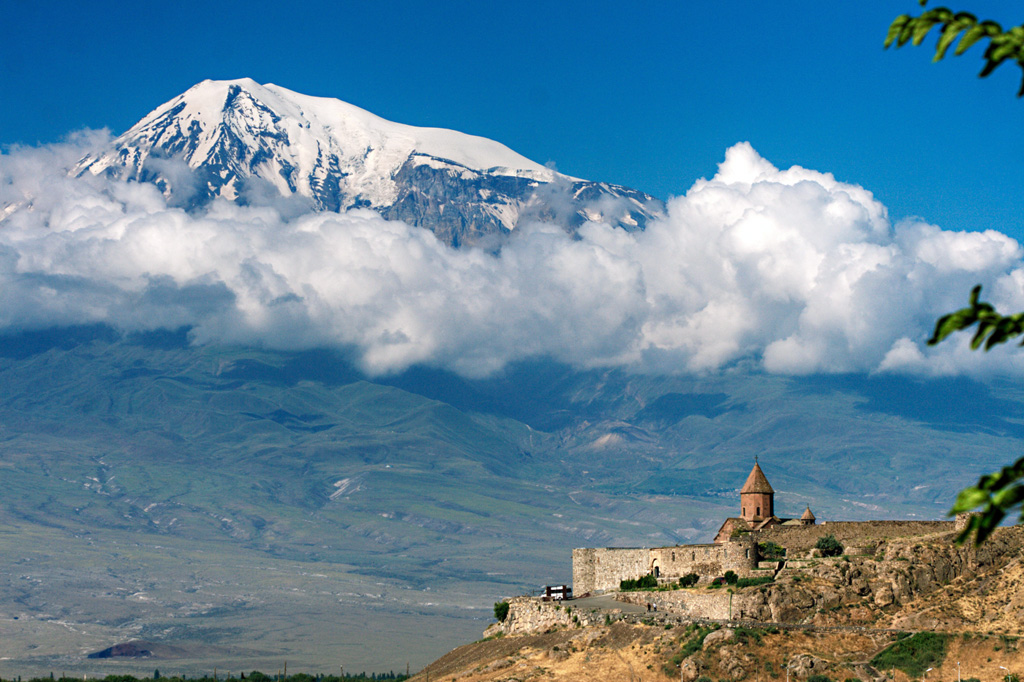
The Global Volcanism Program has no activity reports available for Ararat.
The Global Volcanism Program has no Weekly Reports available for Ararat.
The Global Volcanism Program has no Bulletin Reports available for Ararat.
|
|
||||||||||||||||||||||||||
There is data available for 3 confirmed eruptive periods.
1840 Jul 2 Confirmed Eruption (Explosive / Effusive) VEI: 3 (?)
| Episode 1 | Eruption (Explosive / Effusive) | Upper northern flank | |||||||||||||||||||||||||||||||||||||||||||||||||||||
|---|---|---|---|---|---|---|---|---|---|---|---|---|---|---|---|---|---|---|---|---|---|---|---|---|---|---|---|---|---|---|---|---|---|---|---|---|---|---|---|---|---|---|---|---|---|---|---|---|---|---|---|---|---|---|
| 1840 Jul 2 - Unknown | Evidence from Observations: Reported | |||||||||||||||||||||||||||||||||||||||||||||||||||||
|
List of 9 Events for Episode 1 at Upper northern flank
|
||||||||||||||||||||||||||||||||||||||||||||||||||||||
[ 1783 ] Uncertain Eruption
| Episode 1 | Eruption (Explosive / Effusive) | ||||
|---|---|---|---|---|
| 1783 - Unknown | Evidence from Unknown | |||
[ 1450 ] Uncertain Eruption
| Episode 1 | Eruption (Explosive / Effusive) | ||||
|---|---|---|---|---|
| 1450 - Unknown | Evidence from Unknown | |||
0550 BCE Confirmed Eruption (Explosive / Effusive)
| Episode 1 | Eruption (Explosive / Effusive) | Summit (?) and north flank | |||||||||||||||||||||||
|---|---|---|---|---|---|---|---|---|---|---|---|---|---|---|---|---|---|---|---|---|---|---|---|---|
| 0550 BCE - Unknown | Evidence from Correlation: Anthropology | |||||||||||||||||||||||
|
List of 3 Events for Episode 1 at Summit (?) and north flank
|
||||||||||||||||||||||||
2450 BCE ± 50 years Confirmed Eruption (Explosive / Effusive)
| Episode 1 | Eruption (Explosive / Effusive) | NW flank | |||||||||||||||||||||||||||||||||
|---|---|---|---|---|---|---|---|---|---|---|---|---|---|---|---|---|---|---|---|---|---|---|---|---|---|---|---|---|---|---|---|---|---|---|
| 2450 BCE ± 50 years - Unknown | Evidence from Correlation: Anthropology | |||||||||||||||||||||||||||||||||
|
List of 5 Events for Episode 1 at NW flank
|
||||||||||||||||||||||||||||||||||
This compilation of synonyms and subsidiary features may not be comprehensive. Features are organized into four major categories: Cones, Craters, Domes, and Thermal Features. Synonyms of features appear indented below the primary name. In some cases additional feature type, elevation, or location details are provided.
Synonyms |
||||
| Agri Dagi | Buyuk Agri Dagi | ||||
Cones |
||||
| Feature Name | Feature Type | Elevation | Latitude | Longitude |
| Karniyarik | Cone | |||
| Kucuk Ararat
Kucuk Agri Dagi |
Cone | 3925 m | 39° 39' 0.00" N | 44° 25' 0.00" E |
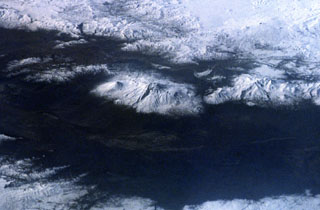 The snow-covered Mount Ararat massif is seen in the center of this 1992 Space Shuttle photo from the NE. The double-peaked stratovolcano is Turkey's highest, largest volume, and eastern-most volcano, near the borders with Armenia and Iran. Postglacial lava flows were erupted from flank fissures, and well-preserved craters are located on the flanks.
The snow-covered Mount Ararat massif is seen in the center of this 1992 Space Shuttle photo from the NE. The double-peaked stratovolcano is Turkey's highest, largest volume, and eastern-most volcano, near the borders with Armenia and Iran. Postglacial lava flows were erupted from flank fissures, and well-preserved craters are located on the flanks.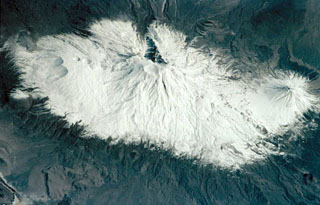 This Space Shuttle image shows the massive 1,000 km3 snow-capped Ararat massif in March 2001. The N-trending feature descending at the top-center from the summit crater is Ahora Gorge. The conical peak of Kucuk Ararat (Lesser Ararat) is visible at the far right, and craters can be seen on the western flank of the massif at the left.
This Space Shuttle image shows the massive 1,000 km3 snow-capped Ararat massif in March 2001. The N-trending feature descending at the top-center from the summit crater is Ahora Gorge. The conical peak of Kucuk Ararat (Lesser Ararat) is visible at the far right, and craters can be seen on the western flank of the massif at the left.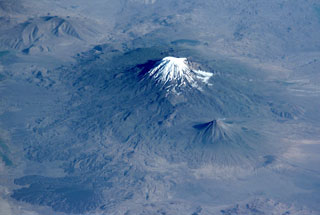 Glacier-clad Mount Ararat, seen in this NASA International Space Station image, is Turkey's highest, largest volume, and easternmost volcano. Kucuk Ararat (or Lesser Ararat) lies across a saddle to the SE (right-center). Prominent lava flows with flow levees were erupted from flank vents between Greater and Lesser Ararat; one of these terminates in a fan-shaped lobe at the lower left. Pyroclastic-flow deposits from Ararat overlie early Bronze Age artifacts.
Glacier-clad Mount Ararat, seen in this NASA International Space Station image, is Turkey's highest, largest volume, and easternmost volcano. Kucuk Ararat (or Lesser Ararat) lies across a saddle to the SE (right-center). Prominent lava flows with flow levees were erupted from flank vents between Greater and Lesser Ararat; one of these terminates in a fan-shaped lobe at the lower left. Pyroclastic-flow deposits from Ararat overlie early Bronze Age artifacts. Snow-capped Mount Ararat is seen from the Khor Virap monastery in Armenia, NE of the volcano. Ararat, also known as Agri Dagi, is Turkey's highest and easternmost volcano, lying near the border with Armenia. Ararat appears to have been active during the 3rd millennium BCE; pyroclastic flow deposits overlie early Bronze Age artifacts and human remains.
Snow-capped Mount Ararat is seen from the Khor Virap monastery in Armenia, NE of the volcano. Ararat, also known as Agri Dagi, is Turkey's highest and easternmost volcano, lying near the border with Armenia. Ararat appears to have been active during the 3rd millennium BCE; pyroclastic flow deposits overlie early Bronze Age artifacts and human remains. 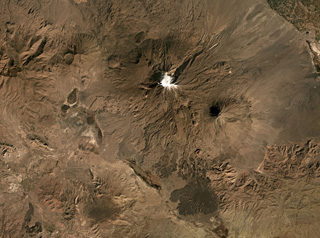 Mount Ararat, or the Ağri Daği volcanic complex, in Turkey has two main edifices, Buyuk Ağrı near the center of this image and the smaller Kucuk Ağri to the SE, both seen in this October 2019 Planet Labs satellite image monthly mosaic (N is at the top; this image is approximately 40 km across). Large recent lava flows form the darker areas to the S of the main glaciated cone.
Mount Ararat, or the Ağri Daği volcanic complex, in Turkey has two main edifices, Buyuk Ağrı near the center of this image and the smaller Kucuk Ağri to the SE, both seen in this October 2019 Planet Labs satellite image monthly mosaic (N is at the top; this image is approximately 40 km across). Large recent lava flows form the darker areas to the S of the main glaciated cone.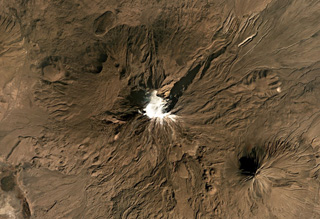 Mount Ararat has two main edifices, the glaciated Buyuk Ağrı in the center and the smaller Kucuk Ağri to the SE of this October 2019 Planet Labs satellite image monthly mosaic (N is at the top; this image is approximately 33 km across). The flanks are lava flows, lava domes, craters, and explosive deposits.
Mount Ararat has two main edifices, the glaciated Buyuk Ağrı in the center and the smaller Kucuk Ağri to the SE of this October 2019 Planet Labs satellite image monthly mosaic (N is at the top; this image is approximately 33 km across). The flanks are lava flows, lava domes, craters, and explosive deposits.The following 1 samples associated with this volcano can be found in the Smithsonian's NMNH Department of Mineral Sciences collections, and may be availble for research (contact the Rock and Ore Collections Manager). Catalog number links will open a window with more information.
| Catalog Number | Sample Description | Lava Source | Collection Date |
|---|---|---|---|
| NMNH 52091-3 | Andesite | -- | -- |
| Copernicus Browser | The Copernicus Browser replaced the Sentinel Hub Playground browser in 2023, to provide access to Earth observation archives from the Copernicus Data Space Ecosystem, the main distribution platform for data from the EU Copernicus missions. |
| MIROVA | Middle InfraRed Observation of Volcanic Activity (MIROVA) is a near real time volcanic hot-spot detection system based on the analysis of MODIS (Moderate Resolution Imaging Spectroradiometer) data. In particular, MIROVA uses the Middle InfraRed Radiation (MIR), measured over target volcanoes, in order to detect, locate and measure the heat radiation sourced from volcanic activity. |
| MODVOLC Thermal Alerts | Using infrared satellite Moderate Resolution Imaging Spectroradiometer (MODIS) data, scientists at the Hawai'i Institute of Geophysics and Planetology, University of Hawai'i, developed an automated system called MODVOLC to map thermal hot-spots in near real time. For each MODIS image, the algorithm automatically scans each 1 km pixel within it to check for high-temperature hot-spots. When one is found the date, time, location, and intensity are recorded. MODIS looks at every square km of the Earth every 48 hours, once during the day and once during the night, and the presence of two MODIS sensors in space allows at least four hot-spot observations every two days. Each day updated global maps are compiled to display the locations of all hot spots detected in the previous 24 hours. There is a drop-down list with volcano names which allow users to 'zoom-in' and examine the distribution of hot-spots at a variety of spatial scales. |
|
WOVOdat
Single Volcano View Temporal Evolution of Unrest Side by Side Volcanoes |
WOVOdat is a database of volcanic unrest; instrumentally and visually recorded changes in seismicity, ground deformation, gas emission, and other parameters from their normal baselines. It is sponsored by the World Organization of Volcano Observatories (WOVO) and presently hosted at the Earth Observatory of Singapore.
GVMID Data on Volcano Monitoring Infrastructure The Global Volcano Monitoring Infrastructure Database GVMID, is aimed at documenting and improving capabilities of volcano monitoring from the ground and space. GVMID should provide a snapshot and baseline view of the techniques and instrumentation that are in place at various volcanoes, which can be use by volcano observatories as reference to setup new monitoring system or improving networks at a specific volcano. These data will allow identification of what monitoring gaps exist, which can be then targeted by remote sensing infrastructure and future instrument deployments. |
| Volcanic Hazard Maps | The IAVCEI Commission on Volcanic Hazards and Risk has a Volcanic Hazard Maps database designed to serve as a resource for hazard mappers (or other interested parties) to explore how common issues in hazard map development have been addressed at different volcanoes, in different countries, for different hazards, and for different intended audiences. In addition to the comprehensive, searchable Volcanic Hazard Maps Database, this website contains information about diversity of volcanic hazard maps, illustrated using examples from the database. This site is for educational purposes related to volcanic hazard maps. Hazard maps found on this website should not be used for emergency purposes. For the most recent, official hazard map for a particular volcano, please seek out the proper institutional authorities on the matter. |
| IRIS seismic stations/networks | Incorporated Research Institutions for Seismology (IRIS) Data Services map showing the location of seismic stations from all available networks (permanent or temporary) within a radius of 0.18° (about 20 km at mid-latitudes) from the given location of Ararat. Users can customize a variety of filters and options in the left panel. Note that if there are no stations are known the map will default to show the entire world with a "No data matched request" error notice. |
| UNAVCO GPS/GNSS stations | Geodetic Data Services map from UNAVCO showing the location of GPS/GNSS stations from all available networks (permanent or temporary) within a radius of 20 km from the given location of Ararat. Users can customize the data search based on station or network names, location, and time window. Requires Adobe Flash Player. |
| DECADE Data | The DECADE portal, still in the developmental stage, serves as an example of the proposed interoperability between The Smithsonian Institution's Global Volcanism Program, the Mapping Gas Emissions (MaGa) Database, and the EarthChem Geochemical Portal. The Deep Earth Carbon Degassing (DECADE) initiative seeks to use new and established technologies to determine accurate global fluxes of volcanic CO2 to the atmosphere, but installing CO2 monitoring networks on 20 of the world's 150 most actively degassing volcanoes. The group uses related laboratory-based studies (direct gas sampling and analysis, melt inclusions) to provide new data for direct degassing of deep earth carbon to the atmosphere. |
| Large Eruptions of Ararat | Information about large Quaternary eruptions (VEI >= 4) is cataloged in the Large Magnitude Explosive Volcanic Eruptions (LaMEVE) database of the Volcano Global Risk Identification and Analysis Project (VOGRIPA). |
| EarthChem | EarthChem develops and maintains databases, software, and services that support the preservation, discovery, access and analysis of geochemical data, and facilitate their integration with the broad array of other available earth science parameters. EarthChem is operated by a joint team of disciplinary scientists, data scientists, data managers and information technology developers who are part of the NSF-funded data facility Integrated Earth Data Applications (IEDA). IEDA is a collaborative effort of EarthChem and the Marine Geoscience Data System (MGDS). |